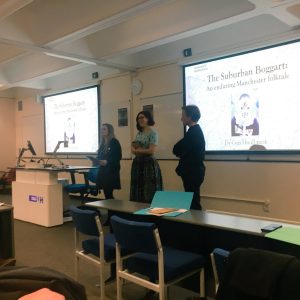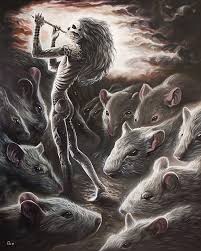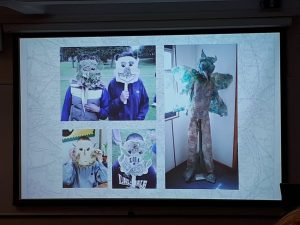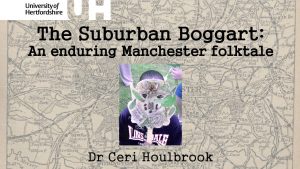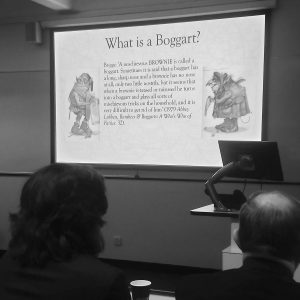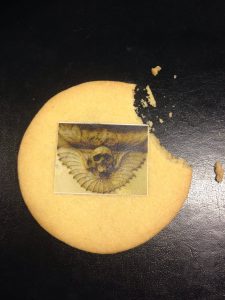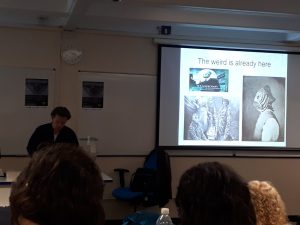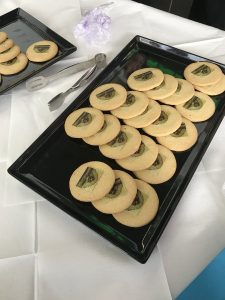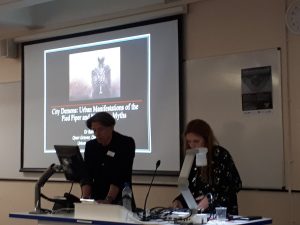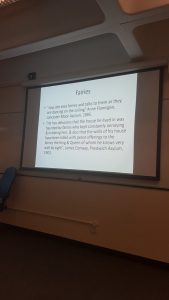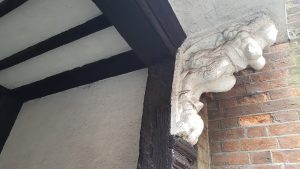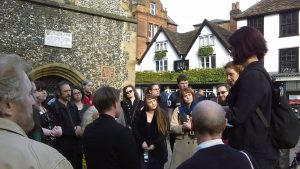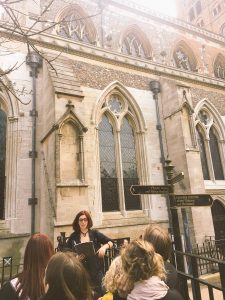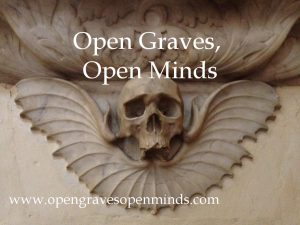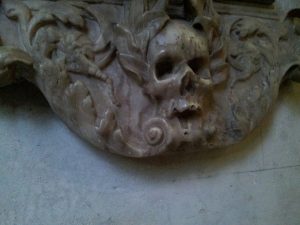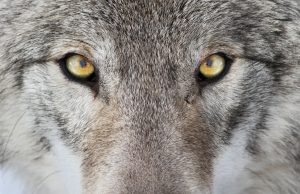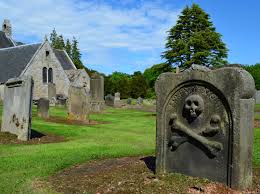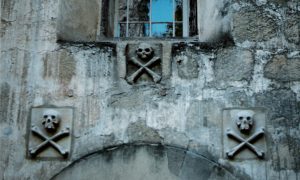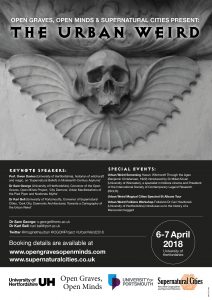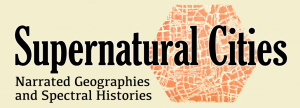Here’s our Twitter ‘Moment’ for #UrbanWeird2018 documenting the fantastic OGOM meets Supernatural Cities conference and tour. Enjoy!
- Join 9,966 other subscribers.
Blog Stats
- 286,480 hits
Site Map
Search by Category:
Meta
Tags
- adaptation
- aesthetics
- Angela Carter
- Animals
- art
- body Gothic
- Bram Stoker
- Buffy the Vampire Slayer
- CFP
- Children's literature
- Company of Wolves
- Conference
- Dracula
- fairies
- fairy tale
- Fairy tales
- Fantasy
- Female Gothic
- Feminism
- Film
- Folklore
- Frankenstein
- gender
- Genre
- Gothic
- Gothic novel
- horror
- Horror Film
- Intertextuality
- Monsters
- music
- myth
- Paranormal romance
- popular culture
- sexuality
- SF
- TV
- Twilight
- Vampires
- Werewolves
- witches
- Wolves
- women
- YA Fiction
- Zombies
Top Posts & Pages
- Welcome
- Mina's Paprika Hendl, inspired by Bram Stoker’s Dracula
- Fairy Tale Hybridity: What Kind of Animal is Beast in 'Beauty and the Beast'?
- What Happens to a Werewolf in the Harvest Moon?
- Angela Carter and the Gothic
- Vampires: Dracula, James Joyce, Jane Austen, bats, and Marx
- Blog
- Carmilla: the most ambiguous female vampire in fiction?
- Beauty and the Beast: A modernist transformation by Clarice Lispector
- Nosferatu at 100 (2022)
Author's Websites
- Aliette de Bodard Aliette de Bodard: Writer of Science Fiction and Fantasy
- Alwyn Hamilton
- Alyxandra Harvey
- Angela Carter The official site of Angela Carter
- Anne Rice
- Betsy Cornwell Betsy Cornwell is a New York Times bestselling author living in west Ireland
- Brenna Yovanoff Brenna Yovanoff’s official site
- Cynthia Leitich Smith
- Daniel Waters's Blog
- Deborah Harkness History professor who tumbled down the rabbit hole and wrote the international best-selling All Souls Trilogy
- Gail Carriger Official website of steampunk and paranormal writer gail Carriger
- Genevieve Cogman Genevieve Cogman’s official site
- Glen Duncan
- Holly Black
- Isaac Marion
- Jackson Pearce Jackson Pearce’s official site
- Jewelle Gomez
- Julia Kagawa Author of YA Iron Fey and lood of Eden series
- Kate Griffin
- Kendare Blake
- Kim Newman Web Site
- Laini Taylor
- Laura Lam
- Laure Eve Laure Eve is the author of novels Fearsome Dreamer, The Illusionists and The Graces
- Life on Magrs (Paul Magrs)
- Maggie Stiefvater Author of YA Wolves of Mercy Falls (Shiver), Lament, and Raven Boys series
- Malinda Lo
- Marcus Sedgwick Author of YA vampire novels My Swordhand is Singing and The Kiss of Death, and many other award-winning novels
- Melissa Marr
- Myth & Moor Terry Windling’s blog
- Neil Jordan
- Rachel Caine
- Robin McKinley
- Rosamund Hodge Rosamund Hodge’s official site
- S. A. Chakraborty
- Samantha Shannon Samantha Shannon’s blog
- Stacey Jay
- Stephenie Meyer
- Tessa Gratton
- Victoria Schwab Victoria Schwab’s official site
Blogroll
- Angela Carter Online News, Reviews, Interviews – everything Angela Carter
- Beyond Twilight: Young Adult Gothic Fiction
- BNTEENBlog Barnes & Noble Teen blog
- Breezes from Wonderland Maria Tatar’s Forum for Storytelling, Folklore, and Children’s Literature
- Centre for Fantasy and the Fantastic
- Centre for Myth Studies, University of Essex The Centre It promotes the study of myth, from ancient to modern, and raises awareness of the importance of myth within the contemporary world.
- Daniel Waters's Blog
- Gothic Imagination (University of Stirling) The Gothic Imagination blog at the University of Sterling
- IGA Postgraduate Forum
- Life on Magrs (Paul Magrs)
- Myth & Moor Terry Windling’s blog
- Mythopoeic Society The Mythopoeic Society is a non-profit organization devoted to the study of mythopoeic literature, particularly the works of members of the informal Oxford literary circle known as the “Inklings.”
- Pook Press Book Blog
- Reading the Gothic: UH Reading Group
- Romancing the Gothic All the Gothic, All the Romance, All the Time
- Samantha Shannon Samantha Shannon’s blog
- Seven Miles of Steel Thistles Katherine Langrish’s blog on fairy tales and YA fantasy
- Sheffield Gothic Sheffield Gothic is a collective group of Postgraduate Students in the School of English at The University of Sheffield with a shared interest in all things Gothic.
- Spectral Visions (University of Sunderland)
- The Vampire Blog (Jennifer Williams)
- Victoria Schwab Victoria Schwab’s official site
- Wellcome Collection Blog
Journals
- Aeternum: The Journal of Contemporary Gothic Studies
- Dark Arts Journal
- Dissections: The Journal of Contemporary Horror Dissections: The Journal of Contemporary Horror
- Echinox Journal Caietele Echinox is a biannual academic journal in world and comparative literature, dedicated to the study of the social, historical, cultural, religious, literary and arts imaginaries
- Fairy Tale Review The website of the Fairy Tale Review journal.
- Fantastika Journal
- Folklore Journal of The Folklore Society. A fully peer-reviewed international journal of folklore and folkloristics, in printed and digital format
- Gothic Nature Gothic Nature: New Directions in Ecohorror and the Ecogothic
- Gothic Studies The official journal of the International Gothic Association considers the field of Gothic studies from the eighteenth century to the present day.
- Gramarye: The Journal of the Chichester Centre for Fairy Tales, Fantasy and Speculative Fiction The Journal of the Chichester Centre for Fairy Tales, Fantasy and Speculative Fiction
- International Journal of Young Adult Literature an academic peer-reviewed journal dedicated to publishing original and serious scholarship on young adult literature from all parts of the world.
- Irish Journal of Gothic and Horror Studies The Irish Journal of Gothic and Horror Studies (ISSN 2009-0374) is a peer-reviewed, interdisciplinary, electronic publication dedicated to the study of Gothic and horror literature, film, new media and television.
- Journal of Popular Romance Studies The Journal of Popular Romance Studies is a double-blind peer reviewed interdisciplinary journal exploring popular romance fiction and the logics, institutions, and social practices of romantic love in global popular culture.
- Journal of the Fantastic in the Arts An interdisciplinary journal devoted to the study of the fantastic in Literature, Art, Drama, Film, and Popular Media
- Lewis Carroll Review The Reviewing Journal of the Lewis Carroll Society
- Mapping the Impossible: Journal for Fantasy Research Mapping the Impossible is an open-access student journal publishing peer-reviewed early-career research into fantasy and the fantastic.
- Marvels & Tales: Journal of Fairy-Tale Studies The journal publishes scholarly work dealing with the fairy tale in any of its diverse manifestations and contexts
- Monsters and the Monstrous Monsters and the Monstrous is a biannual peer reviewed global journal that serves to explore the broad concept of “The Monster” and “The Monstrous” from a multifaceted inter-disciplinary perspective.
- Otranto.co.uk: The New Strawberry Hill Press Otranto.co.uk: The New Strawberry Hill Press
- Pennywise Dreadful: The Journal of Stephen King Studies Journal of Stephen King Studies
- Preternature: Critical and Historical Studies on the Preternatural Preternature provides an interdisciplinary, inclusive forum for the study of topics that stand in the liminal space between the known world and the inexplicable.
- Revenant: Critical and Creative Studies of the Supernatural
- Slayage: The Journal of the Whedon Studies Association
- Studies in Gothic Fiction
- Studies in the Fantastic Studies in the Fantastic is a journal devoted to the Speculative, Fantastic, and Weird in literature and other arts
- Supernatural Studies Supernatural Studies is a peer-reviewed journal that promotes rigorous yet accessible scholarship in the growing field of representations of the supernatural, the speculative, the uncanny, and the weird.
- The Lion and the Unicorn The Lion and the Unicorn, an international theme- and genre-centered journal, is committed to a serious, ongoing discussion of literature for children.
- Thinking Horror: a journal of horror philosophy
- Victorian Popular Fictions Journal Victorian Popular Fictions is the journal of the Victorian Popular Fiction Association. The VPFA is a forum for the dissemination and discussion of new research into nineteenth- and early-twentieth-century popular narrativeo
Related Links
- Aarne-Thompson-Uther Index The Aarne-Thompson-Uther Index is a classification numeric system created to group similar folktales from different cultures
- ACADEmy LSAD centre for research into Art, Curatorial Studies, Applied Design and Art and Design Education
- African Religions With the Yoruba Religion Reader and similar resources
- Angela Carter Society Promoting the study and appreciation of the life and work of Angela Carter
- Art Passions Art Passions: Fairy Tales are the Myths We Live By
- Baldwin Library of Historical Children's Literature Baldwin Library of Historical Children’s Literature
- Black Romance Timeline History of Black authors of romantic fiction
- British Association for Romantic Studies (BARS) The UK’s leading national organisation for promoting the study of Romanticism and the history and culture of the period from which it emerged.
- British Association for Victorian Studies (BAVS) The British Association for Victorian Studies (BAVS) is a multidisciplinary organisation dedicated to the advancement and dissemination of knowledge about the Victorian period.
- Byron Society The Byron Society celebrates the life and works of Lord George Gordon Byron (1788-1824), a poet, traveller and revolutionary
- Centre for Contemporary Legend
- Centre for Fantasy and the Fantastic
- Centre for Folklore Myth Magic A home and meeting point for Folklore and Storytelling in the North
- Centre for Myth Studies, University of Essex The Centre It promotes the study of myth, from ancient to modern, and raises awareness of the importance of myth within the contemporary world.
- Centre for the History of the Gothic (University of Sheffield)
- Chichester Centre for Fairy Tales, Fantasy and Speculative Fiction
- Encyclopedia of Science Fiction
- Fairy Investigation Society, The a website that will gather together sources, links, bibliographical references and discussions on fairies and related supernatural creatures
- Fantastic Fiction Bibliographies for fantastic fiction
- Fantasy Literature Fantasy and Science Fiction book reviews
- Folk Horror Revival Folk Horror Revival is a gathering place to share and discuss Folk Horror in film, TV, books, art, music, events and other media.
- Folklore and Mythology – Electronic Texts
- Folklore Society The Folklore Society (FLS) is a learned society, based in London, devoted to the study of all aspects of folklore and tradition, including: ballads, folktales, fairy tales, myths, legends, traditional song and dance, folk plays, games, seasonal events, ca
- Folklore Thursday
- Gothic Charm School An essential guide for Goths and those who love them
- Gothic Feminism Gothic Feminism is a research project based at the University of Kent which seeks to re-engage with theories of the Gothic and reflect specifically upon the depiction of the Gothic heroine in film
- Gothic Women Project 2023: The Year of Gothic Women. An interdisciplinary project devoted to spotlighting undervalued and understudied women writers
- Gothica: University of Birmingham
- Gothicise Gothicise Fine Art Collective
- Hans Christian Andersen Centre
- Haunted Shores Haunted Shores Research Network, dedicated to investigating coasts and littoral space in Gothic, horror, and fantastic multimedia
- IAFA: The International Association for the Fantastic in the Arts The purpose of IAFA is to promote and recognize achievement in the study of the fantastic
- International Fairy-Tale Filmography Searchable database of fairy tale film adaptations
- International Gothic Association
- Mabinogion Pathfinder Many links to resources for the medieval Welsh collection of romances, The Mabinogion
- Manchester Centre for Gothic Studies (MMU)
- MEARCSTAPA monsters: the experimental association for the research of cryptozoology through scholarly theory and practical application
- Mermaids of the British Isles a history of mermaids in the arts and cultural imagination of our early islands, which will map the place of these beguiling, and often deadly, figures in the national maritime imaginary, and explore our ancestors’ persistent reimagining of the mermaid
- My So-called Undeath: My Life as a Zombie (Daniel Waters) The fictional blog of Tommy from Daniel Water’s Generation Dad series
- Mythological Africans Exploring African mythologies, spiritualities and cultures
- Mythology and Folklore UN-Textbook Content for a course in Myth & Folklore taught at the University of Oklahoma
- Open Folklore Open Folklore is devoted to increasing the number of useful resources, published and unpublished, available in open access form for folklore studies and the communities with which folklorists partner
- PCA Vampire Studies A site dedicated to the Vampire Studies Area of the Pop Culture Association
- Pook Press Publisher of Vintage Illustrated Fairy Tales, Folk Tales and Children’s Classics
- Romance Scholarship DB Very full bibliography of secondary reading on romantic fiction
- RomanceWiki A wiki resource for romance fiction authors, texts, and publishers
- Romancing the Gothic All the Gothic, All the Romance, All the Time
- Science Fiction and Fantasy Research Database The Science Fiction and Fantasy Research Database is a freely available online resource designed to help students and researchers locate secondary sources for the study of the science fiction and fantasy and associated genres.
- Shapeshifters in Popular Culture
- Sophie Lancaster Foundation The charity, known as The Sophie Lancaster Foundation, will focus on creating respect for and understanding of subcultures in our communities.
- Speculative Fiction in Translation
- Spine-chillers and suspense: A timeline of Gothic fiction
- Supernatural Cities Supernatural Cities is an interdisciplinary network of humanities and social science scholars of urban environments and the supernatural.
- Supernatural Studies Association The Supernatural Studies Association is an organization dedicated to the academic study of representations of the supernatural, the speculative, the uncanny, and the weird across periods and disciplines.
- The Secret Commonwealth
- The Thinker's Garden we also love Plotinus and the Renaissance Platonists, as well as the Transcendentalists and Romantics. We are also drawn to the peculiarities of the Theosophists and hermeticists of the nineteenth century
- TheoFantastique
- UK Wolf Conservation Trust
- Vamped Vamped is a general interest non-fiction vampire site. We publish interviews, investigations, lists, opinions, reviews and articles on various topics.
- Victorian Popular Fiction Association The Association is committed to the revival of interest in understudied popular writers, literary genres and other cultural forms.
- Wells at the World's End I am reading through the complete works of H G Wells, in chronological order. This blog is for my jottings, as I go along.
- Whedon Studies Association
- YA Literature, Media, and Culture YALMC is a resource for those of us researching, writing, writing about, interested in Young Adult Literature, Media, and Culture.
- YA Studies Association (YASA) The YA Studies Association (YASA) is an international organisation existing to increase the knowledge of, and research on, YA literature, media, and related fields

